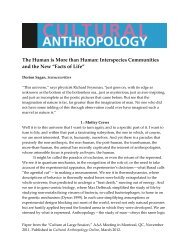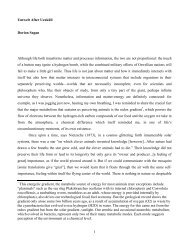PESTICIDES IN COCA-COLA AND PEPSI - Cultural Anthropology
PESTICIDES IN COCA-COLA AND PEPSI - Cultural Anthropology
PESTICIDES IN COCA-COLA AND PEPSI - Cultural Anthropology
You also want an ePaper? Increase the reach of your titles
YUMPU automatically turns print PDFs into web optimized ePapers that Google loves.
CULTURAL ANTHROPOLOGY 22:4<br />
(developed) countries such as the Netherlands and that Coca-Cola is produced by a 200-year-old<br />
company.<br />
15. Interestingly, the fact that production and marketing of Coca-Cola and Pepsi in India is undertaken<br />
by local subsidiaries does not dilute their connotation of being “foreign” brands.<br />
16. In Pakistan, Naqvi describes “family as the vessel of middle class consumerism” (2005:4318).<br />
According to him, Coca-Cola is now shifting to a more differentiated strategy of “brand<br />
association” with youth culture, as opposed to interjecting itself in representations of national<br />
culture.<br />
17. In a fit of self-righteous rage, the CEO of PepsiCo India called the controversy a “trial by<br />
Kangaroo Courts”: “These have been very unfortunate and sad days for our civil society . . . this<br />
is yet another instance where our democracy and constitutional freedom of speech are being<br />
used to sensationalize a non-issue.” The crisis, according to the CEO, was not because of the<br />
absence of standards for beverages, or the presence of pesticides in Pepsi, but because of lack of<br />
“norms for our society at large and NGOs in particular and the rules of engagement” (Bakshee<br />
2003).<br />
18. The Coca-Cola Company and PepsiCo’s sponsorship of cricket also came under a cloud. An<br />
article entitled, “Cricket Sponsorship in Jeopardy,” mentioned that “sources in the Board of<br />
Control for Cricket in India (BCCI) and Doordarshan [the state-owned television channel] said<br />
that if the two companies were implicated for any wrong doing, they might wash their hands<br />
off Pepsi” (Shukla 2003b).<br />
19. Even the slogan raised at some of these anti-Coca-Cola–Pepsi demonstrations, “Quit India,” is<br />
the same as Gandhi’s ultimatum to the British in 1942. “In Mumbai, protestors smashed soft<br />
drink bottles and demanded a ban on the two brands. ‘Quit India . . . Coke and Pepsi,’ read a<br />
placard” (Hindustan Times 2003).<br />
20. In a highly symbolic act, India’s Parliament banned Coca-Cola and Pepsi in its cafeteria, and,<br />
instead, offered “lassi [buttermilk], coconut water, and lemonade” (Das 2003). The purpose<br />
was to strip Coca-Cola and Pepsi of the legitimacy of being “quality” products consumed by<br />
the ruling elite.<br />
21. The equation of “foreign” with “impure” appears to be a characteristic of culinary classification,<br />
cross-culturally (Douglas and Wildavsky 1982; Liechty 2005) and, especially, in case of food<br />
in Indian culture, which is saturated with notions of purity and pollution, therefore, serving<br />
as a powerful social marker of inclusion as well as exclusion, hierarchy, and status (Appadurai<br />
1988).<br />
Editor’s Note: Other <strong>Cultural</strong> <strong>Anthropology</strong> articles have also examined the practices and effects<br />
of MNCs. See, for example, Suzana Sawyer’s “Bobbittizing Texaco: Dis-Membering Corporate<br />
Capital and Re-Membering the Nation in Ecuador” (2002). Articles that examine middle-class<br />
formations and practices include Vassos Argyrou’s “ ‘Keep Cyprus Clean’: Littering, Pollution,<br />
and Otherness” (1997) and Susan A. Reed’s “Performing Respectability: The Beravā, Middle-<br />
Class Nationalism, and the Classicization of Kandyan Dance in Sri Lanka” (2002).<br />
REFERENCES CITED<br />
Agrawal, Anil, and Sunita Narain<br />
1991 Global Warming in an Unequal World: A Case of Environmentalism. Delhi: Center<br />
for Science and Environment.<br />
Appadurai, Arjun<br />
1988 How to make a National Cuisine: Cookbooks in Contemporary India. Comparative<br />
Studies in Society and History 30(1):3–24.<br />
1996 Modernity at Large: <strong>Cultural</strong> Dimensions of Globalization. Public Worlds, vol.<br />
1. Minneapolis: University of Minnesota Press.<br />
Applbaum, Kalman<br />
2000 Crossing Borders: Globalization as Myth and Charter in American Transnational<br />
Consumer Marketing. American Ethnologist 27(2):257–282.<br />
680






